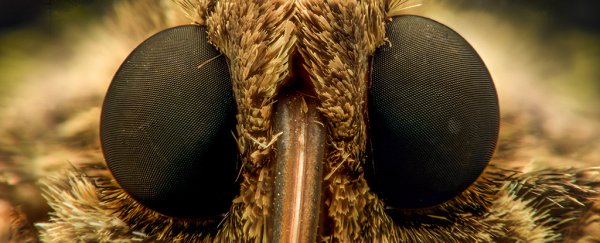A new kind of transparent film inspired by the eyes of moths could soon be on its way to help cut the glare on your phone's screen without sapping its battery.
Not only could the technology make it four times easier to see your screen out in the sunlight, it is flexible enough to adapt to curved screens, all while keeping its surface free of dust and fingerprints.
The team of engineers from the US and Taiwan took their cue from the nanostructures in moths' eyes, which help the insects avoid becoming lunch by trapping light that could otherwise be reflected and give them away to predators.
As light passes from the air to the moth-eye's curved surface, waves are bent or 'refracted' in such a way that they scatter without producing a visible shine as they bounce back out again.
You might not need to worry about predators spotting a stray reflection from your phone, but light bouncing from its shiny surface is still pretty annoying.
Anti-reflection and anti-glare coatings are nothing new, but most have problems in that they either reduce the amount of light getting through, only reflect certain wavelengths, are easily damaged, or are expensive.
Most smart phones get around the problem by detecting light levels and pumping up their screen's brightness to compensate, a somewhat effective solution that also drains a lot of battery.
Constructing a tough, transparent material that scatters light-waves coming in from one direction while letting maximum light pass through from another direction would solve many of these problems, if it could be done cheaply.
Moth-eyes have inspired this kind of material before, applied as a coating for solar cells, while similar refractive coatings have also been made by etching a surface so it scatters light in destructive ways.
Making a coating that will expand to cover an entire tablet screen was more of a challenge.
"Although it is known that moth-eye structures can reduce surface reflection, it is relatively difficult to fabricate an antireflection film with this nanostructure that is large enough to use on a mobile phone or tablet," says Shin-Tson Wu of the University of Central Florida.
Their moth-eye model aimed to solve the problem of glare, self-cleaning, and potential cost of fitting over a phone or tablet-sized device, without interfering with the screen's resolution.
The team constructed a material with tiny dimples about 100 nanometres in diameter, all about 10 nanometres apart and used a mathematical model to tweak its finer details.
For scale, about a thousand of those dimples could fit across the width of a human hair.
"Because the structures are so small, a high-resolution and high-precision fabrication technique is necessary," says Wu.
The material was produced using a solution of tiny spheres of silicon dioxide which was smoothed out into a single layer using a centrifuge, making for a rather simple manufacturing process.
A typical iPhone screen might reflect back around 4.4 percent of the light around you; a film with these dimples would reflect back just 0.23 percent of the light.
In application, the material provided a four-fold improvement in contrast ratio – the difference between the darkest and brightest shades on the screen – when it was viewed in the sunlight. In the shade, the contrast was 10 times better.
"Our film provides an efficient and low-cost method to reduce the surface reflection and improve the sunlight readability of mobile devices," says Wu.
Since the researchers have already shown their mathematical models can be used to optimise their film, they hope to find a way to squeeze even more efficiency out of the process, while finding a balance between making the material tougher and more flexible.
We expect moths will soon be lining up to put in their orders for tiny goggles.
This research was published in Optica.
